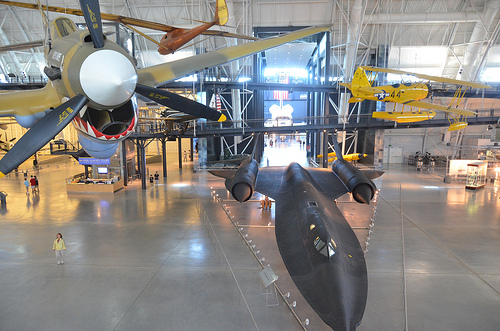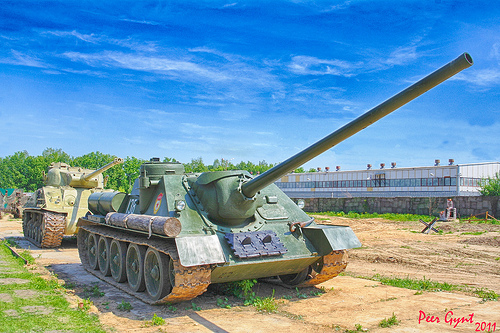Some cool prototype factory in china photos:
Steven F. Udvar-Hazy Center: P-40 Warhawk, SR-71 Blackbird, Naval Aircraft Factory N3N seaplane, Space Shuttle Enterprise

Image by Chris Devers
Quoting Smithsonian National Air and Space Museum | Curtiss P-40E Warhawk (Kittyhawk IA):
Whether or not known as the Warhawk, Tomahawk, or Kittyhawk, the Curtiss P-40 proved to be a effective, versatile fighter during the very first half of World War II. The shark-mouthed Tomahawks that Gen. Claire Chennault’s "Flying Tigers" flew in China against the Japanese remain among the most well-known airplanes of the war. P-40E pilot Lt. Boyd D. Wagner became the first American ace of World War II when he shot down six Japanese aircraft in the Philippines in mid-December 1941.
Curtiss-Wright constructed this airplane as Model 87-A3 and delivered it to Canada as a Kittyhawk I in 1941. It served until 1946 in No. 111 Squadron, Royal Canadian Air Force. U.S. Air Force personnel at Andrews Air Force Base restored it in 1975 to represent an aircraft of the 75th Fighter Squadron, 23rd Fighter Group, 14th Air Force.
Donated by the Exchange Club in Memory of Kellis Forbes.
Manufacturer:
Curtiss Aircraft Firm
Date:
1939
Nation of Origin:
United States of America
Dimensions:
Overall: 330 x 970cm, 2686kg, 1140cm (10ft 9 15/16in. x 31ft 9 7/8in., 5921.6lb., 37ft four 13/16in.)
Components:
All-metal, semi-monocoque
Physical Description:
Single engine, single seat, fighter aircraft.
• • • • •
See far more images of this, and the Wikipedia article.
Particulars, quoting from Smithsonian National Air and Space Museum | Lockheed SR-71 Blackbird:
No reconnaissance aircraft in history has operated globally in much more hostile airspace or with such full impunity than the SR-71, the world’s fastest jet-propelled aircraft. The Blackbird’s performance and operational achievements placed it at the pinnacle of aviation technology developments for the duration of the Cold War.
This Blackbird accrued about 2,800 hours of flight time during 24 years of active service with the U.S. Air Force. On its final flight, March six, 1990, Lt. Col. Ed Yielding and Lt. Col. Joseph Vida set a speed record by flying from Los Angeles to Washington, D.C., in 1 hour, four minutes, and 20 seconds, averaging three,418 kilometers (2,124 miles) per hour. At the flight’s conclusion, they landed at Washington-Dulles International Airport and turned the airplane more than to the Smithsonian.
Transferred from the United States Air Force.
Manufacturer:
Lockheed Aircraft Corporation
Designer:
Clarence L. "Kelly" Johnson
Date:
1964
Country of Origin:
United States of America
Dimensions:
General: 18ft 5 15/16in. x 55ft 7in. x 107ft 5in., 169998.5lb. (five.638m x 16.942m x 32.741m, 77110.8kg)
Other: 18ft 5 15/16in. x 107ft 5in. x 55ft 7in. (five.638m x 32.741m x 16.942m)
Materials:
Titanium
Physical Description:
Twin-engine, two-seat, supersonic strategic reconnaissance aircraft airframe constructed largley of titanium and its alloys vertical tail fins are constructed of a composite (laminated plastic-type material) to lessen radar cross-section Pratt and Whitney J58 (JT11D-20B) turbojet engines feature large inlet shock cones.
• • • • •
Quoting Smithsonian National Air and Space Museum | Naval Aircraft Factory N3N:
In 1934 the Naval Aircraft Factory in Philadelphia was tasked to manufacture a new principal trainer for the U.S. Navy. Following effective tests, this tiny biplane trainer was built in each land and seaplane versions. The Navy initially ordered 179 N3N-1 models, and the factory began producing far more than 800 N3N-3 models in 1938. U.S. Navy principal flight coaching schools utilized N3Ns extensively all through Globe War II. A few of the seaplane version have been retained for primary training at the U.S. Naval Academy. In 1961 they became the last biplanes retired from U.S. military service.
This N3N-three was transferred from Cherry Point to Annapolis in 1946, exactly where it served as a seaplane trainer. It was restored and displayed at the Naval Academy Museum just before getting transferred here.
Transferred from the United States Navy
Manufacturer:
Naval Aircraft Factory
Date:
1941
Country of Origin:
United States of America
Dimensions:
General: 10ft 9 15/16in. x 25ft 7 1/16in. x 34ft 1 7/16in., 2090lb. (330 x 780 x 1040cm, 948kg)
Materials:
bolted steel-tube fuselage construction with removable side panels wings, also constructed internally of all metal, covered with fabric like the fuselage and tail.
Physical Description:
Vibrant yellow bi-plane, hand crank commence. Cockpit instrumentation consists of an altimeter, tachometer, airspeed indicator, compass, turn and bank indicator, and a mixture fuel and oil temperature and pressure gauge, floats.
• • • • •
See a lot more pictures of this, and the Wikipedia write-up.
Details, quoting from Smithsonian National Air and Space Museum | Space Shuttle Enterprise:
Manufacturer:
Rockwell International Corporation
Country of Origin:
United States of America
Dimensions:
General: 57 ft. tall x 122 ft. long x 78 ft. wing span, 150,000 lb.
(1737.36 x 3718.57 x 2377.44cm, 68039.6kg)
Components:
Aluminum airframe and body with some fiberglass functions payload bay doors are graphite epoxy composite thermal tiles are simulated (polyurethane foam) except for test samples of actual tiles and thermal blankets.
The initial Space Shuttle orbiter, "Enterprise," is a full-scale test automobile employed for flights in the atmosphere and tests on the ground it is not equipped for spaceflight. Though the airframe and flight handle components are like these of the Shuttles flown in space, this automobile has no propulsion system and only simulated thermal tiles since these functions have been not necessary for atmospheric and ground tests. "Enterprise" was rolled out at Rockwell International’s assembly facility in Palmdale, California, in 1976. In 1977, it entered service for a nine-month-extended approach-and-landing test flight system. Thereafter it was utilised for vibration tests and fit checks at NASA centers, and it also appeared in the 1983 Paris Air Show and the 1984 World’s Fair in New Orleans. In 1985, NASA transferred "Enterprise" to the Smithsonian Institution’s National Air and Space Museum.
Transferred from National Aeronautics and Space Administration
Dedication to the Excellent Victory Day. Soviet Self Propelled Tank Destroer SU-100. 1944-45. Ко дню Великой Победы. Советская Самоходка СУ-100.

Image by Peer.Gynt
Moscow. Technical Museum of Vadim Zadorozhny.
www.youtube.com/watch?v=n7ghaMEy0l8
The SU-one hundred was a Soviet casemate-style tank destroyer. It was utilised extensively during the final year of World War II and saw service for numerous years afterwards with the armies of Soviet allies around the globe.
It was developed in 1944 as an improvement to the SU-85, constructed on the very same chassis as the T-34-85 tank. It was designed and built at the UZTM (Russian abbreviature УЗТМ for Уральский Завод Тяжелого Машиностроения – Ural Heavy Machinery Factory, also known as Uralmash) in Yekaterinburg. The SU-one hundred quickly proved itself to be among the very best self-propelled anti-tank guns of Planet War II, able to penetrate 125 mm (four.9 in) of vertical armor from a variety of two,000 m (1.two mi) and the sloped 85 mm (three.3 in) front armor of the German Panther from 1,500 m (.93 mi).[citation necessary] The improvement was carried out under supervision of L. I. Gorlitskiy, chief designer of all medium Soviet self-propelled guns. The operate started in February 1944 and 1st prototype of SU-100, referred to as "Object 138", was constructed in March. Right after intensive testing with various models of one hundred mm gun Soviet engineers authorized the D-10S gun for mass production. This gun was created in Constructors Bureau of Artillery Factory No. 9 under guidance of F. F. Petrov. Soon after the Second World War it was installed on T-54 and T-55 tanks and its derivatives were in service forty years soon after initial improvement. The hull of SU-100 had main improvements over the SU-85 the thickness of the front armour was improved from 45 to 75 mm (1.eight to 3. in), and the commander’s workplace was created in a modest sponson on the right side of the hull combined with the commander’s cupola this greatly improved the commander’s effectiveness. For greater ventilation two ventilator units had been installed, as an alternative of only one particular as in the SU-85. Mass production began in September 1944.
The SU-one hundred saw comprehensive service for the duration of the last year of the war. It was employed en masse in Hungary in March 1945, when Soviet forces defeated the German Operation Frühlingserwachen offensive at Lake Balaton. By July 1945, 2,335 SU-100s had been constructed.
The vehicle remained in service with the Red Army properly soon after the war production continued in the Soviet Union until 1947 and into the 1950s in Czechoslovakia. It was withdrawn from Soviet service in 1957 but many automobiles were transferred to reserve stocks. Some exist to this day in the Russian Army holding facilities.
A lot of Warsaw Pact nations also used the SU-100, as did Soviet allies such as Egypt, Angola and Cuba. A few SU-100 had been delivered to Yugoslavia soon after the war, under the designation M-44.[1] The SU-one hundred saw service in the fighting that accompanied the 1956 Suez Crisis, in which the Egyptians employed SU-100s against Israel’s M4 Sherman tanks. The automobile was also utilized in the 1967 Six-Day War and the 1973 Yom Kippur War. It was modified slightly to adapt it to the sandy conditions of the Middle East, therefore making the SU-100M variant. Exported SU-100s continued in service until the 1970s, and in some countries, even later. Yugoslavs utilized them during the civil war nonetheless due to lack of spare parts they have been speedily retired, but performed satisfactorily. The SU-one hundred remains in use by the Vietnam People’s Army and the Korean People’s Army Ground Force regardless of the age of the design.
SU-100s entered service with the People’s Liberation Army (PLA) of China after 1 December 1950 when Soviet forces left Dalian. The armaments in Dalian were sold to China, such as 99 SU-100s, 18 IS-two heavy tanks, 16 T-54s and 224 T-34s, with which PLA formed its 1st Mechanised Division.
In well-known culture [edit]
The crew of a Globe War II SU-100 and their car are the heroes of the old Soviet film «На войне как на войне» Na vojne kak na vojne ("All’s fair in adore and war" (actually: "In wartime it really is like wartime"), 1 of many Soviet films produced about self-propelled artillery men. Veterans of the German-Soviet War discovered this image quite realistic. The film consists of a Soviet tankmen song, which is well-liked with each Russian armoured soldiers and civilians.
A SU-one hundred is utilized by the protagonists in the movie The Misfit Brigade, exactly where it is portrayed as a German tank, possibly due to the fact it resembles the Jagdpanzer 38 (t) tank destroyer and the Jagdpanther. Ironically, the film has a scene where the Germans spot one particular, supposedly captured by the Russians, and proclaim: "That’s a single of ours! It positive is, and it is a terrible paint job. You can still see the cross! … Ivan’s pinched my tank!" The film is also known as Wheels of Terror, based on the book by Sven Hassel.